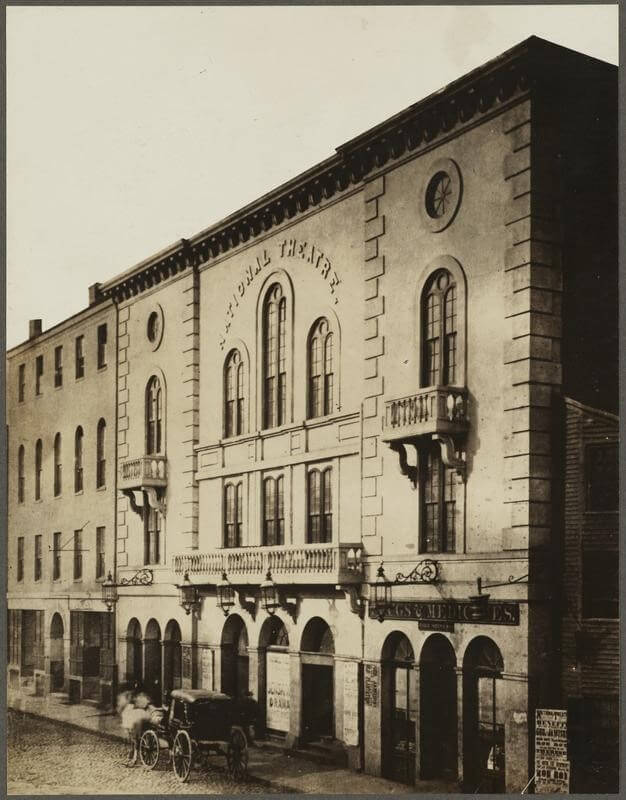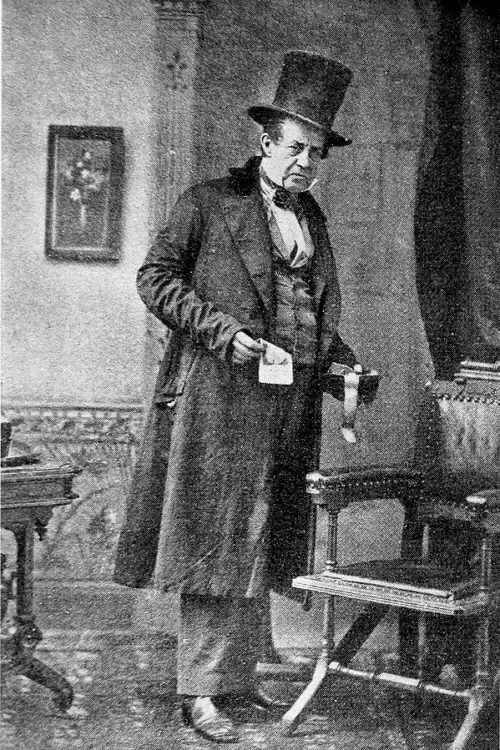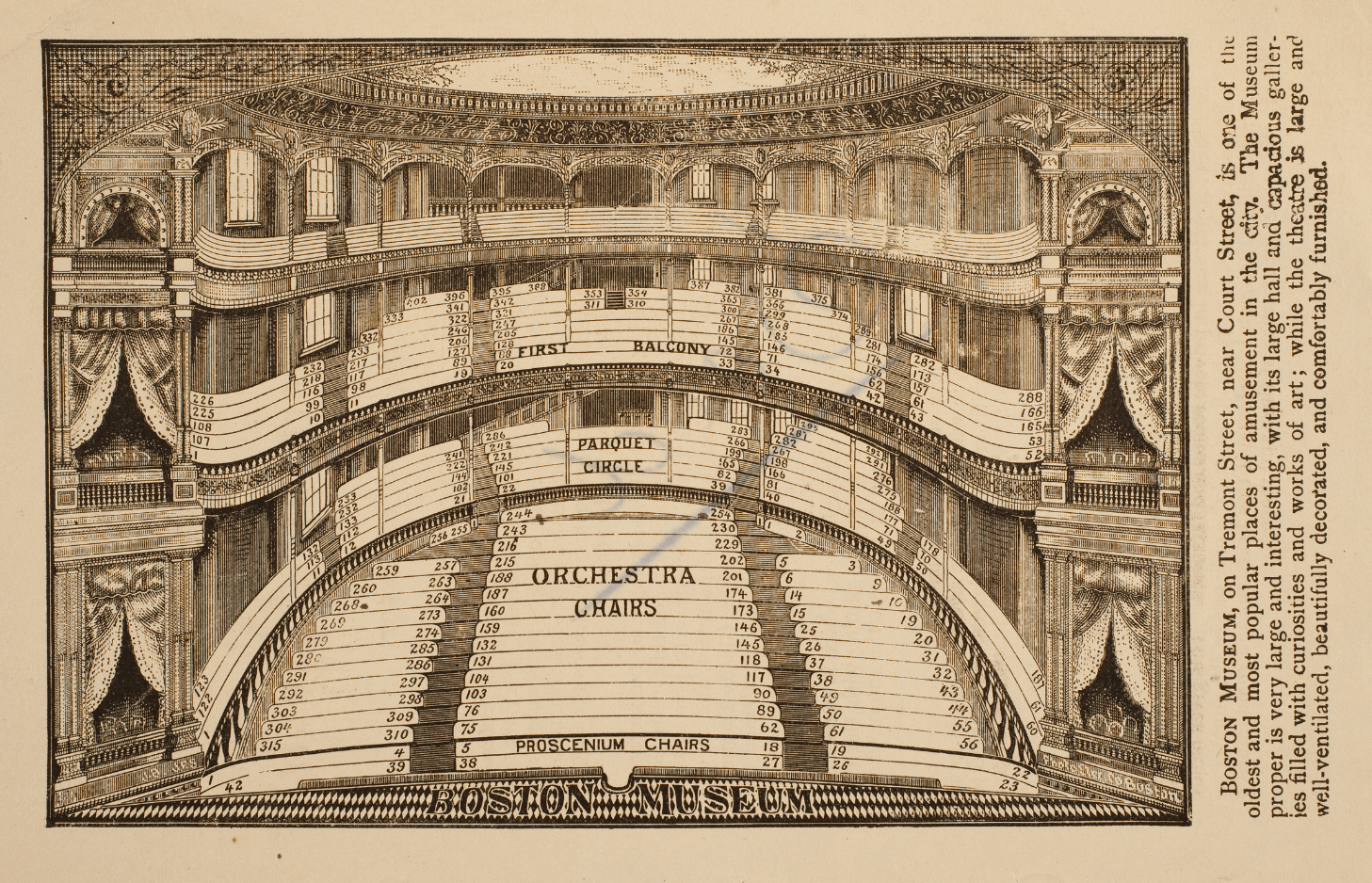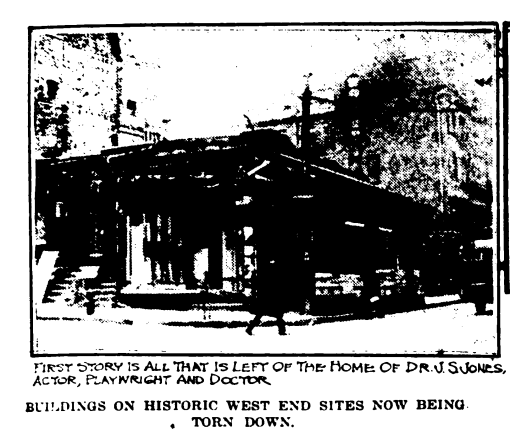Dr. Joseph Stevens Jones
Dr. Joseph Stevens (J.S.) Jones, who lived most of his life in the West End, was a successful actor, playwright, theater manager, and physician in the nineteenth century. Jones graduated from Harvard Medical School and wrote between 150 and 200 plays in his lifetime. In 1924, the City of Boston tore down Dr. Jones’s home on Bowdoin Street, and other historic West End sites, in order to widen Court and Cambridge Streets.
Dr. Joseph Stevens (J.S.) Jones was born in Boston on September 28, 1809 at the corner of Eliot and Tremont Streets. His father, Abraham Jones, was the second mate on the merchant ship O’Cain, which sailed from Boston to trade with China and along the Northwest Coast. In 1803, Abraham Jones became an interpreter for Aleksandr Baranov, governor of the Russian-American company, after Baranov and captain Joseph O’Cain agreed to cooperate in hunting sea otters, and sharing the catch, to subsequently trade with China. The O’Cain transported the indigenous Aleutian laborers employed by Baranov as hunters. When J.S. Jones was ten, Abraham died on the island of Unalaska in the Aleutian Islands; he may have been killed by native people after hostilities ensued. The Jones family soon moved to the West End, residing on the corner of Cambridge and Bowdoin Streets.
Jones attended the Boston public schools, and worked in a cordage (rope) store and the “counting-house” of a banker. While picking up practical business experience, Jones cultivated a deep interest in plays and pursued both acting and playwriting. He participated in “private theatricals,” or productions put on at house parties for elites (as opposed to public theaters). The banker Jones worked under discovered that his clerk was interested in theater, and used his connections to secure a part for Jones in an upcoming production in Providence, Rhode Island. Jones played the role of “Crack” in a comedy called “The Turnpike Gate,” and his performance was received positively by critics. Upon returning to Boston, Jones acted in many of his own productions at the Tremont Theatre, on 88 Tremont Street (open from 1827-1843). Author John Bouvé Clapp, in his biography of Jones (published in the Boston Transcript in 1910) wrote that Jones became “a favorite with Boston theatregoers and his dramatization of ‘Eugene Aram’, which was successful, added to his fame” (Jones adapted the play from a novel based on the true story of Aram, an English scholar executed in 1759 for murdering his business partner).
Jones later worked as an actor, playwright, and stage manager at the Warren Theatre, later called the National Theatre, in the West End. On the corner of Portland and Traverse Streets, William Pelby established the National Theatre in 1836 on the site of the American Ampitheater, which was built in 1832 and briefly called the Warren Theatre. In 1832, the Warren Theatre presented Jones’ “Liberty Tree, or the Boston Boys,” which had Jones play the lead character (a comedy role) and supported by a cast of “some of the most popular Boston players of the day.” In 1837, the new National Theatre’s first production was Jones’ “Carpenter of Rouen,” a successful play that later became a popular “stock piece” in Great Britain. In addition to writing many plays for the National Theatre, Jones managed its financial affairs. In 1839, the owners of the Tremont Theatre offered him management of their playhouse with a four-year lease. Jones negotiated for the right to end the lease after half of its term (two years) passed, and in 1841 he cut ties with the theater after two lackluster seasons. When the Tremont closed for good in 1843, Jones retired from acting after performing in two plays in New York and Philadelphia respectively.
While working for William Pelby at the National Theatre, Jones studied surgery at Harvard Medical School. At the time, Jones had no intention of pursuing the medical profession; his enrollment in medical school merely reflected his “avidity for knowledge.” Jones graduated some time after he retired from acting, and taught courses on anatomy and physiology at Tremont Temple in addition to working as a practicing physician. Dr. Jones continued regularly writing plays, many of which were commissioned by theater managers who simply wanted the prolific playwright’s name on the billing. Boston’s medical community occasionally recognized Jones’s theatrical prowess, such as when the Boston Medical and Surgical Journal reported on December 27, 1848, in its “Medical Miscellany” section, that “Dr. J.S. Jones, of Boston, has received the prize recently offered for the best local drama.” In 1858, Jones was credited with a successful “pumpkin-seed remedy” for treating human parasites by the same journal.
Jones could not personally recall how many plays he wrote in total, but estimates range between 150 and 200 plays over his lifetime. Many of his productions were based upon historical events and figures, such as “The Siege of Boston,” “Moll Pitcher” [sic] (for Mary Hays, the woman who fought in the Revolutionary War), and “Paul Revere and the Sons of Liberty.” Jones’ most successful play in Boston was “The Silver Spoon, or Our Own Folks: A Joiner’s Job in Four Parts,” produced in 1852 and held at the Boston Museum, a theater hall between Scollay Square and School Street. “The Silver Spoon” satirized the state legislature, and William Warren acted in the lead role as Jefferson Scattering Batkins, the fictional representative from “Cranberry Centre.” The Boston Museum put on “The Silver Spoon” for three weeks on account of its popularity, even among actual members of the state legislature. J.S. Jones followed up with a sequel, “Batkins at Home, or Life in Cranberry Centre,” which did not take off, and a novel published in 1871 called “Life of Jefferson S. Batkins, Member from Cranberry Centre. Written by Himself.” Jones dedicated the novel to William Warren, the actor, and Moses Kimball, who built the Boston Museum. Kimball replied to “My Dear Doctor,” in a letter dated September 25, 1871, that “Batkins” was a “very ingenious narrative” which had really “shown up the shortcomings and intrigues of ‘legislators’.” “Paul Revere” was Jones’ last play, produced on March 6, 1876 at the Boston Museum.
Dr. Jones died at his 1 Bowdoin Street residence on December 29, 1877. One of his three sons, Nathaniel “Nat” D. Jones, was a well-known Boston actor and comedian in his own right until he died in 1912. Nat Jones owned the copyright on the 1911 edition of “The Silver Spoon,” reproduced by Boston-based publisher Walter Baker for “The William Warren Edition of Standard Plays.” In 1924, Dr. Jones’s home was one of the historic West End sites torn down to widen Cambridge and Court Streets. The Boston Globe profiled each of the neighborhood’s historic buildings being razed or moved by the new thoroughfare, and remarked that “a few old Bostonians still remember…when West End boys availed themselves of the opportunity to coast from Beacon St. down Bowdoin St., swinging around Dr. Jones’s corner into Cambridge Street.” The Globe acknowledged then how “50 years ago,” as Dr. Jones’ childhood home was torn down for urban redevelopment, he built a legacy as an actor, playwright, and physician in the West End.
Article by Adam Tomasi
Source: Internet Archive (Clark’s Boston Blue Book; From the Volga to the Yukon by Daniel Henderson, 1914); Google Books (Boston Medical and Surgical Journal; The Silver Spoon); West End Museum (National Theatre); Famous Americans; E.W. Geisicke, “Discovery of Humboldt Bay, California, in 1806 from the Ship O’Cain, Jonathan Winship, Commander: An Episode in a Bostonian-Russian Contract Voyage of the Early American China Trade”; Boston Athenaeum; Boston Globe (“Famous Landmarks in West End Razed to Widen Court and Cambridge Sts,” December 28, 1924, page 17)











